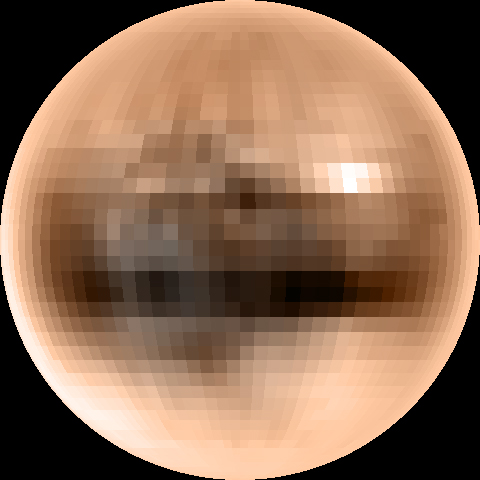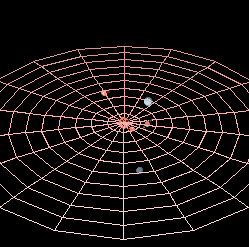Pluto is a real challenge to astronomers. Since Pluto is so far from Earth, little is known about the planet’s size or surface conditions so astronomers roughly estimate. Its average distance from the Sun is about 5.9 billion km and it is located within the Kuiper Belt. Pluto’s semi major axis is 39.5 AU. Pluto is smaller and less massive than other planets and moons in the solar system. Pluto has an estimated radius less than one fifth that of Earth or only about two-thirds as wide as Earth’s moon or about 2,302 km. That’s about half the width of the United States. Pluto has a density that of twice the times of water or 2.1 grams per centimeter cubed. Because of it’s small density, Pluto has a small core. The mass of Pluto is .024 percent than that of earth or 1.31 times ten to the power of 22 kg. It would take about 454 Pluto’s to equal the mass of the Earth. The gravity on Pluto is 7% than the gravity of Earth. A person that is weighing 200 pounds on Earth would weigh 14 pounds on Pluto. The planet’s surface probably consist of a rocky core surrounded by a mantle of water ice. Pluto has a thin atmosphere and it contains nitrogen, methane, and perhaps other heavier gases. So what is the weather on Pluto like? Pluto’s surface is one of the coldest places in the solar system. Pluto is very, very cold. The temperature on Pluto is 375 to 400 degrees below zero day and night. So there is a high possibility that we can imagine that Pluto may be covered in ice. Because it’s so icy, Pluto is very reflective. So for people that hate the summer, Pluto is your place to go. Although astronomers talk about Pluto having large quantities of ice, it’s actually a dirty brown color. They discovered this when Charon passed in front of Pluto. According to NASA when Charon passed in front of Pluto, it made the regions of the dwarf planet to go darker. As soon as that happened, astronomers subtracted the light from Pluto to get an approximate guess of Pluto’s color. It was then when the astronomers found out that Pluto had darker and lighter regions when they were expecting a pure snowy ball.
Pluto has a thin atmosphere and it contains nitrogen, methane, and perhaps other heavier gases. So what is the weather on Pluto like? Pluto’s surface is one of the coldest places in the solar system. Pluto is very, very cold. The temperature on Pluto is 375 to 400 degrees below zero day and night. So there is a high possibility that we can imagine that Pluto may be covered in ice. Because it’s so icy, Pluto is very reflective. So for people that hate the summer, Pluto is your place to go. Although astronomers talk about Pluto having large quantities of ice, it’s actually a dirty brown color. They discovered this when Charon passed in front of Pluto. According to NASA when Charon passed in front of Pluto, it made the regions of the dwarf planet to go darker. As soon as that happened, astronomers subtracted the light from Pluto to get an approximate guess of Pluto’s color. It was then when the astronomers found out that Pluto had darker and lighter regions when they were expecting a pure snowy ball.

Pluto’s rotation period is -6.4 days. Just like Venus and Uranus, Pluto rotates backwards or in a retrograde motion. A Plutonian day is around 153 hours. It takes Pluto 248 years to go around the sun. The orbit of Pluto is so highly eccentric that is actually crosses inside the orbit of Neptune. Because of this, Pluto is actually closer to the Sun than Neptune for 20 years. Pluto has a 17-degree inclination in its orbit meaning there is no chance that it will eventually collide with Neptune. Because of this Pluto’s distance from the Sun varies from 4.4 billion km to 7.4 billion km. Every other planet in the solar system makes a circle when they orbit the sun but Pluto does not. Pluto orbits the sun in an oval like a racetrack and that is because of it’s high inclined and eccentric orbit. Pluto’s atmosphere changes as well because of its orbit. When Pluto is close to the sun, its surface ices warm up and then rise and temporarily form a thin atmosphere and then when it gets further away, the atmosphere freezes again, surrounding the surface in a thin layer. It isn’t known whether Pluto has a magnetic field, but its small size and slow rotation suggest little or no magnetic field. If you would like to watch a video on how astronomers imagine what Pluto is like, you may do so by clicking here.
Pluto’s atmosphere changes as well because of its orbit. When Pluto is close to the sun, its surface ices warm up and then rise and temporarily form a thin atmosphere and then when it gets further away, the atmosphere freezes again, surrounding the surface in a thin layer. It isn’t known whether Pluto has a magnetic field, but its small size and slow rotation suggest little or no magnetic field. If you would like to watch a video on how astronomers imagine what Pluto is like, you may do so by clicking here.



